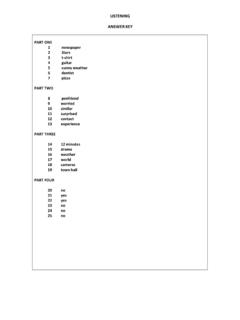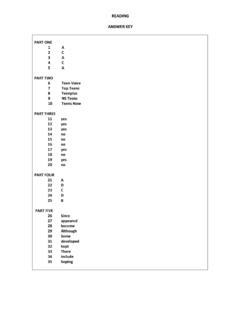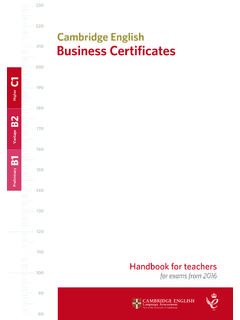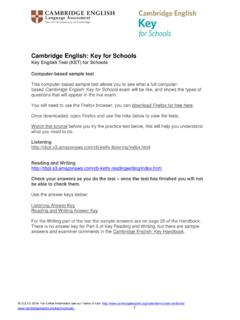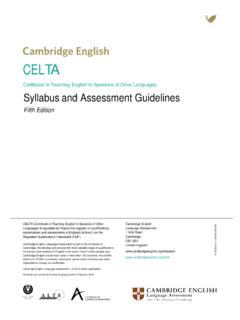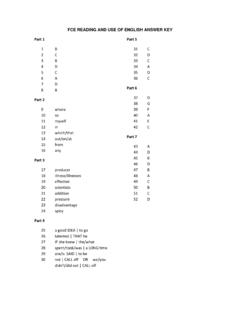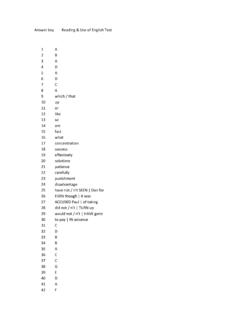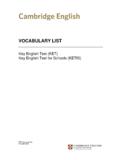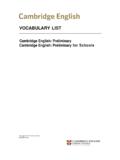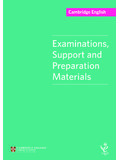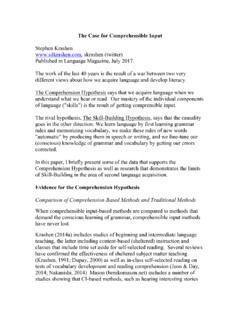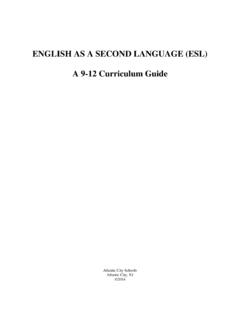Transcription of Framework components - Cambridge Assessment English
1 Framework Categories and components 2 Cambridge English Teaching FrameworkFramework componentsEach category and sub-category of the Framework is made up of components . The explanations below set out what is meant by these components in the Framework . They are intended to be indicative of the key principles and concepts relevant to each component and are not meant to be Learning and the LearnerThe following areas of knowledge and competence are grouped under the heading Learning and the Learner , and are important in that they provide a conceptual and theoretical basis on which teachers consciously or unconsciously develop their personal understandings of teaching and learning. Learning theories; this refers to: general learning theories ( , constructivism, humanism, behaviourism, social-constructivism) concepts (such as multiple intelligences, motivation, scaffolding, experiential learning, higher-order thinking skills, meta-cognition, stages of cognitive development, etc.)
2 , and factors which affect these demonstration of practical application for language learning and and SLA; this refers to: theories of first (FLA) and second language learning (SLA) concepts (such as critical period, noticing, interlanguage, immersion, information processing, implicit/explicit learning, comprehensible input , etc.) classroom SLA research findings (with regard to L1 transfer, corrective feedback, individual differences, similarities and differences between first language acquisition in an immersion environment and additional language acquisition in a classroom environment, etc.) demonstration of practical application for language learning and methodologies; this refers to: approaches and methods for teaching language ( , communicative approach, task-based learning (TBL), audio-lingual, grammar-translation, etc.)
3 Concepts (such as explicit teaching, discovery learning, noticing, error correction, L1 interference) demonstration of practical application for language learning and learners; this refers to: concepts such as learning preferences, multiple intelligences, learning strategies, special needs, affect differences in types of learners and teaching contexts (such as young learners vs. adults, monolingual vs. multilingual classes, large classes, beginners vs. advanced learners, mixed-ability classes, etc.) demonstration of practical application for language learning and Categories and components 3 Cambridge English Teaching Framework2. Teaching, Learning and AssessmentThe following areas of knowledge and competence are each important in their own right, but have been grouped together under the six sub-categories within the overall heading Teaching, Learning and Assessment for ease of reference.
4 Teachers abilities in these different aspects of teaching involve not only the practical application of knowledge (as expressed in category 1 above), but also familiarity with and practice in using a range of different teaching Planning language learning Lesson planning; this refers to: key concepts and principles ( , identifying learner needs, setting aims, anticipating learners difficulties, staging and timing, selecting appropriate activities/materials/resources and interaction patterns, sequencing of activities/lessons, learner differentiation, etc.) following/adapting appropriate templates for individual lessons and a series of lessons demonstration of practical application for language learning and teaching when planning and in class awareness of how effective teaching leads to learning learning to respond appropriately according to the flow of a lesson and learners planning; this refers to: key organisational principles in course planning ( , needs analysis, setting objectives, sequencing, Assessment , evaluation, etc.)
5 The demonstration of practical application for language learning and teaching when planning a series of lessons and/or a whole course, including the ability to work creatively within the constraints of a prescribed Using language-learning resources and materialsSelecting, adapting, supplementing and using learning materials; this refers to: key principles for critically evaluating, selecting, adapting, supplementing and exploiting coursebook and supplementary materials the demonstration of how to apply these principles to a selected coursebook unit or set of learning materials for a specified context in order to achieve desired learning outcomes demonstrating the ability to improvise when certain learning materials, resources and technology are limited, unavailable or not teaching aids; this refers to: core techniques for using the board, visuals, realia and audio/visual equipment, as well as techniques for teaching without such aids core techniques for using digital teaching aids ( , interactive whiteboards, PowerPoint, etc.)
6 Demonstration of the ability to use these techniques effectively in a specified context in order to engage and motivate learners. Categories and components 4 Cambridge English Teaching FrameworkUsing digital resources; this refers to: familiarity with key concepts related to digital teaching/learning ( , blended learning, flipped classroom, etc.) core principles and techniques for selecting and using digital/online resources, where available, as a resource for learning ( , digital videos, podcasts, learning platforms such as Moodle, downloading tasks onto mobile devices, etc.) key practical skills ( , computer skills, typing, searching the internet, finding web-based materials, use of social media, etc.) demonstration of the ability to use some or all of these techniques and skills effectively in a specified context in order to achieve desired learning outcomes and promote learner autonomy, and the ability to improvise when such digital resources are unavailable or not Managing language learningCreating and maintaining a constructive learning environment; this refers to: key concepts and principles for learner-centred teaching, establishing rapport, classroom management, maintaining discipline (especially in large classes and/or with young learners), creating a positive learning environment, motivating, involving and engaging learners, keeping learners on task, ensuring a suitable pace, managing transitions between stages in a lesson, etc.
7 Demonstration of practical application through a variety of appropriate teaching techniques in a specified context in order to achieve desired learning to learners; this refers to: key concepts and principles for teacher talk, wait time, question types ( , genuine/display, open/closed), nominating, elicitation, use of L1, grouping of learners, oral feedback, interaction patterns ( , whole class, pair work, group work), etc. understanding of learner differences, preferences and difficulties demonstration of practical application through a variety of appropriate teaching techniques in a specified context in order to achieve desired learning up and managing classroom activities; this refers to: key activity formats for starting and ending lessons (such as warmers, fillers, etc.) key principles for giving and checking instructions, demonstrating activities, giving preparation time before activities, grouping learners, monitoring and checking learning, encouraging interaction with and between learners, etc.
8 Demonstration of practical application through a variety of appropriate teaching techniques in a specified context in order to achieve desired learning feedback on learner language; this refers to: key principles and techniques for providing positive and corrective feedback: on learners spoken language ( , teacher-led correction, learner self-correction, peer correction, reformulation, etc.) on learners written language (such as use of drafting, peer-checking, error codes, etc.) demonstration of practical application through a variety of appropriate teaching techniques in a specified context in order to achieve desired learning outcomes.(The ability to recognise these errors is covered in category 3 Language Ability below.) Categories and components 5 Cambridge English Teaching Teaching language systemsTeaching vocabulary; this refers to: key principles and techniques for introducing and practising vocabulary ( , inductive/deductive presentation, creating a context, form/meaning/use, concept-checking, drilling, controlled/freer practice, recycling/revision, use of visuals, use of concordances, etc.)
9 Understanding of corpus linguistics and frequency, learning strategies (such as vocabulary journals, mnemonics, dictionary skills, etc.) concepts such as synonymy/antonymy/hyponymy, collocation, lexical phrases, etc. demonstration of practical application of all the above through a variety of appropriate teaching techniques in a specified context in order to achieve desired learning grammar; this refers to: key concepts, principles and techniques for introducing and practising grammar ( , inductive/deductive presentation, creating a context, use of timelines, form/meaning/use, concept-checking, drilling, controlled/freer practice, recycling/revision, etc.) understanding of different lesson shapes (such as Presentation, Practice and Production (PPP), Test-Teach-Test (TTT), Task-based Learning (TBL), etc.)
10 Key terms for describing grammar demonstration of practical application through a variety of appropriate teaching techniques in a specified context in order to achieve desired learning phonology; this refers to: key concepts, principles and techniques for raising awareness of and practising phonology, for the purposes of both listening and speaking, ( , sounds/phonemes of a chosen variety of English , use of phonemic script/chart, stress and weak forms, connected speech, intonation, etc.) key terminology for describing sounds ( , plosives/fricatives/bi-labials, etc.), stress ( , word and sentence stress, schwa, etc.), connected speech ( , liaison/juncture/intrusion, etc.), and intonation ( , rhythm, rising/falling intonation, etc.) demonstration of practical application through a variety of appropriate teaching techniques in a specified context in order to achieve desired learning discourse; this refers to: key concepts, principles and techniques for raising awareness of and practising discourse features ( , genre, coherence, cohesion, speech acts, turn-taking, etc.)
